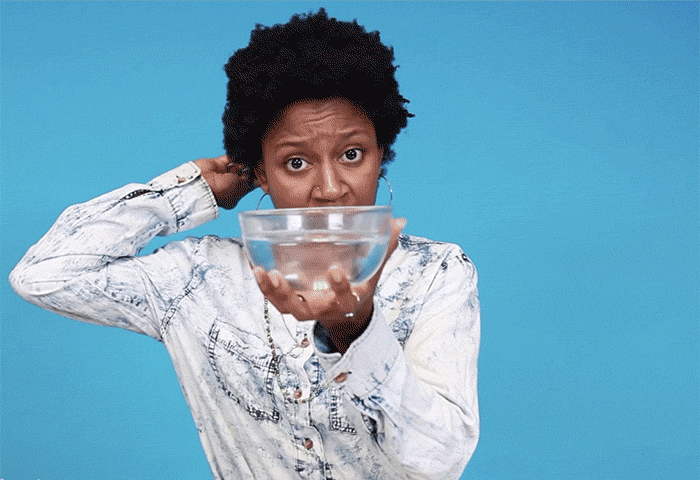
Whether you’re new to the curly scene or a faithful veteran, the terms “hair porosity” and “hair density” have most likely been brought to your attention. If not, then add both of them to your vocabulary, because hair porosity and hair density are equally important in determining the best care for your curls.
Determining Hair Porosity
In the naturally curly world, hair porosity simply refers to the hair’s ability to absorb moisture. Depending on the condition of your hair, your cuticle layers could be very open allowing a lot of moisture to enter. On the opposite side of the spectrum, your hair’s cuticle layers could be very tight and preventing moisture to penetrate it. High porosity means your hair is very porous and allows a lot of moisture in. Low porosity means that your hair is less porous and is resistant to moisture.
How can you determine whether or not your hair is highly porous? There are many ways to test this, but the easiest is to conduct a “floating hair test.”

- Take a couple of strands of your hair and drop them into a bowl of water.
- Let them sit in the bowl for about two to four minutes.
- Observe your hair. If you hair is floating in the water, you have low porosity. If your hair is sinking, you have high porosity.
There’s more than one way to figure out your porosity. Check out these other porosity tests here.
How should my hair porosity affect my regimen?
If your hair strands stayed afloat, this means that you have low porosity. Your hair is typically resistant to moisture. This does not mean that your hair is unhealthy; it simply means that you need to help your hair retain moisture. Try using lighter hair products with humectants, and utilize heat! Heat can be your best friend if you have low porosity. Wash and condition your hair with warm water, and deep condition under a hooded dryer (or hold a hair dryer over your head”>.
If you hair strands sunk in the bowl of water, your hair is highly porous. It easily absorbs moisture and therefore is mostly likely prone to frizz. Highly porous hair requires a little more effort to maintain, but it’s nothing a well planned hair regimen can’t handle! Try adding some protein rich products to your hair regimen, such as an avocado deep conditioner. Porous hair needs protein to fill in the gaps, so look for hair products with proteins such as aloe and wheat protein.
How to Determine Your Hair Density
It’s important to make a distinction between “hair density” and “hair strand thickness.” Hair strand thickness is self explanatory, but hair density refers to how many strands of hair you have on one square inch of your head. The average person has 2,200 strands of hair per square inch. Of course hair density differs greatly from person to person, and if you’re a curly girl, it’s even more difficult to determine. Hair density can be classified into three levels: low, medium and high.
If you have thick hair strands, you will more than likely have high hair density, but this is not always the case. Hair density is often diagnosed by a professional who will either conduct a strand count or take a “phototrichogram.” A phototrichogram is a close up photo of individual hair strands, which professionals use to count hair strands and determine hair density. But if you want to conduct a density test at home, try conducting the “pony tail test.”
- Smooth out your hair as much as possible with a comb or your fingers, and then gather and tie it into a ponytail.
- Measure the circumference of your ponytail. Low density hair will be less than two inches, medium density hair will be two to three inches and thick hair will be four or more inches.

Why is Hair Density Important?
Hair density is an important factor to consider when planning your hair regimen and hairstyle. If you have low density hair, consider using light products that won’t weigh down your hair. Use a mousse with a volumizing agent to give the appearance of thicker hair, and consider leave-in conditioners that contain thickening agents. When deciding on your next hairstyle, look for styles that are simple or rounded. You curls will naturally fall into place and give the appearance of more volume.
If your hair density is high, you want to stick to heavier products that will help hold your thick curls together. Lucky for you, there is an abundance of curly hair products for styling, including gels, creams, butters, etc. Utilize these to help your curls stay in place. If you’re thinking about your next hairstyle, consider layers, as these are best supported by thick hair.
The Best Products for Your Hair Density
- Thin hair: Moptop Light Hold Anti-Frizz Gel
- Medium hair: Living Proof No Frizz Wave Shaping Curl Defining Styling Cream
- Thick hair: Miss Jessie’s Curly Meringue
Once you’ve determined your hair porosity and hair density, you can make wiser decisions as to how to care for your curls. Have fun planning your next hair regimen!
Did you do the porosity test? What are your results? Do you know of any other tests for hair density and porosity? We would love to hear about them!
Want More?
How to Condition High Porosity Hair – And KEEP It Moisturized
How to Moisturize Your Stubborn, Low Porosity Hair
Still not sure how your hair’s density should impact your regimen? Learn more about why density matters.
Once you understand the density of your hair – something that you cannot change – you can learn to accept and work with what you’ve got!






